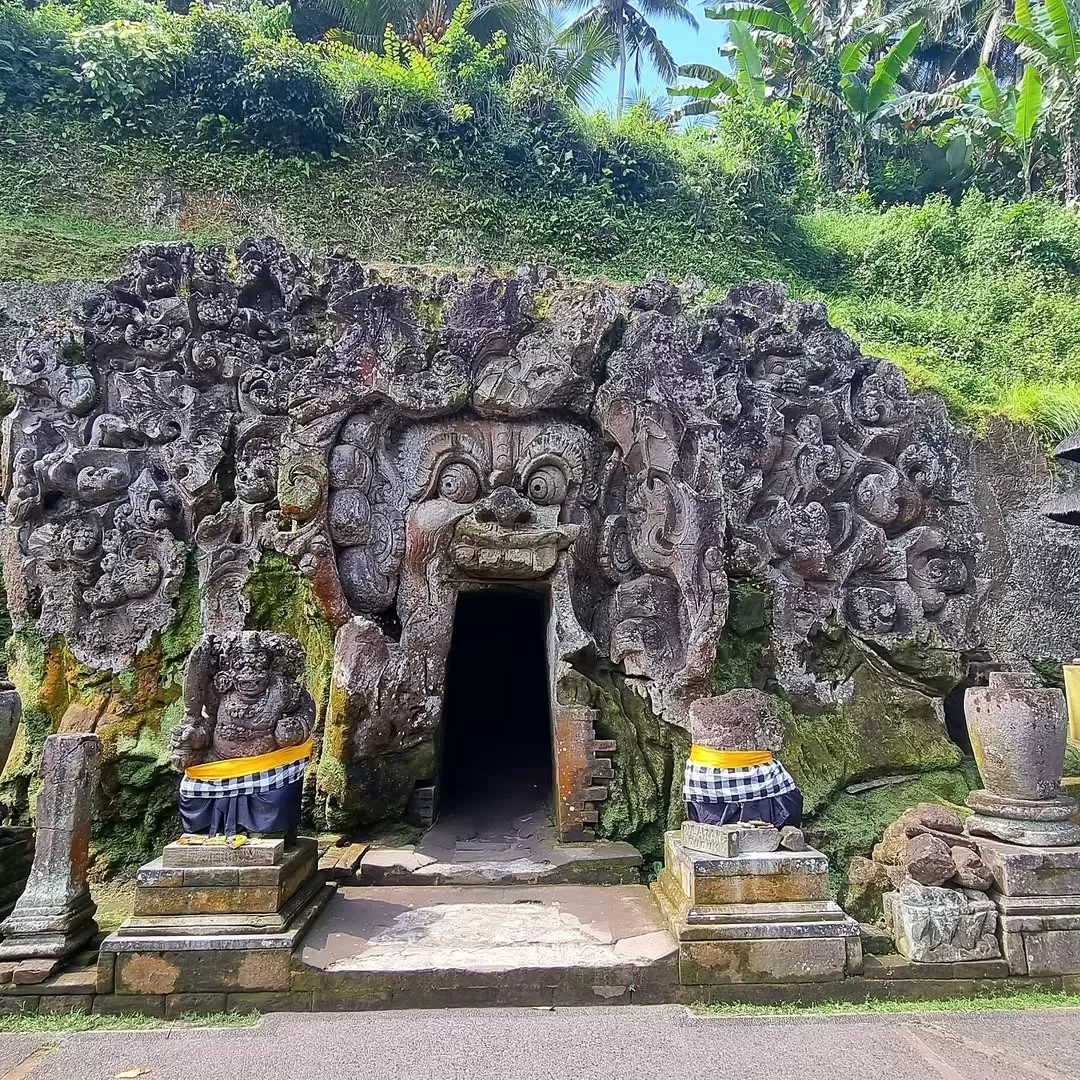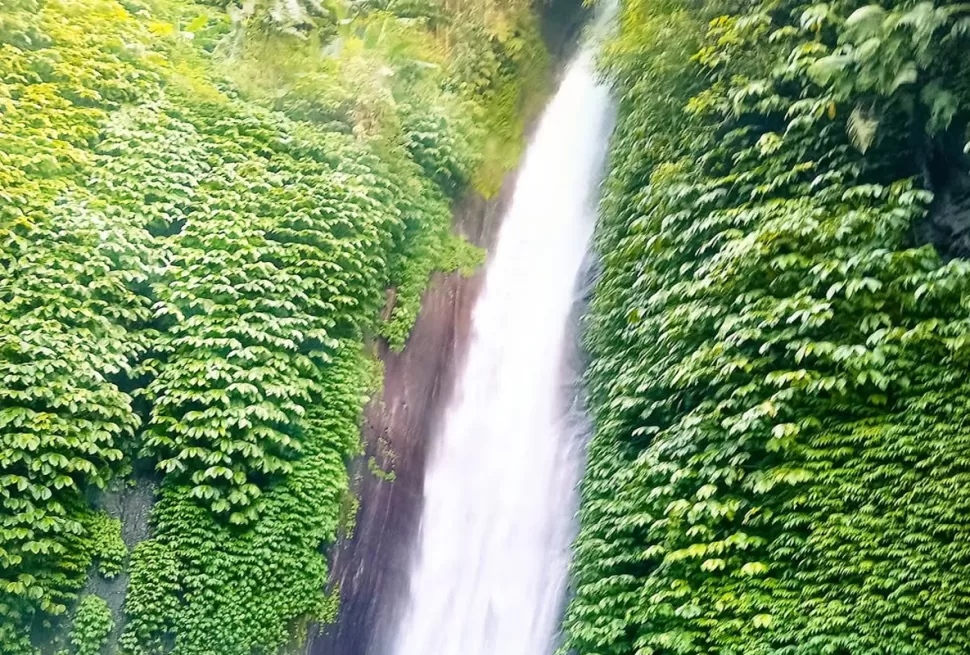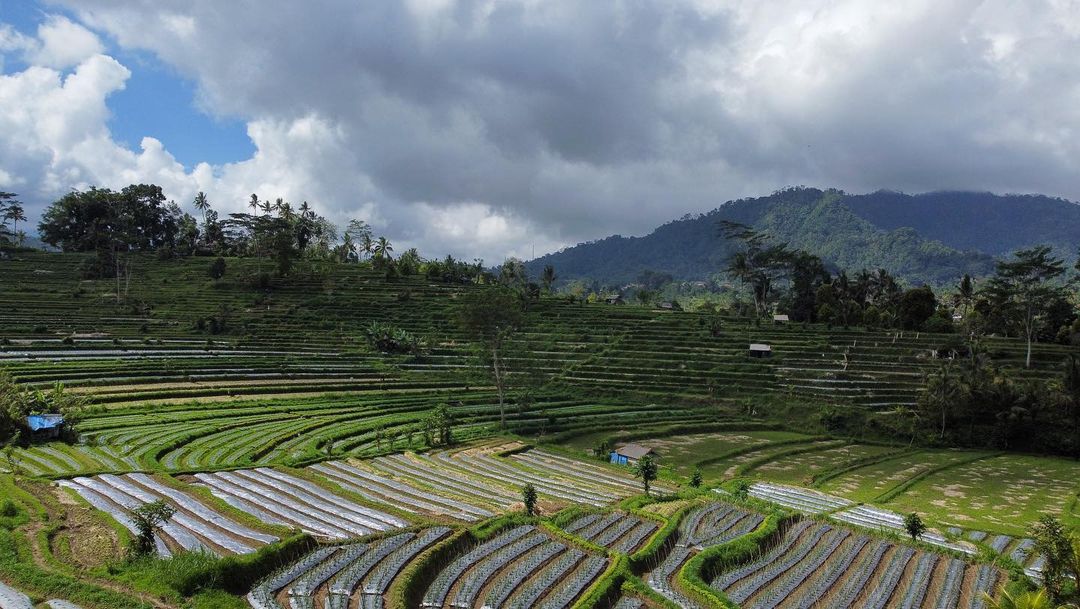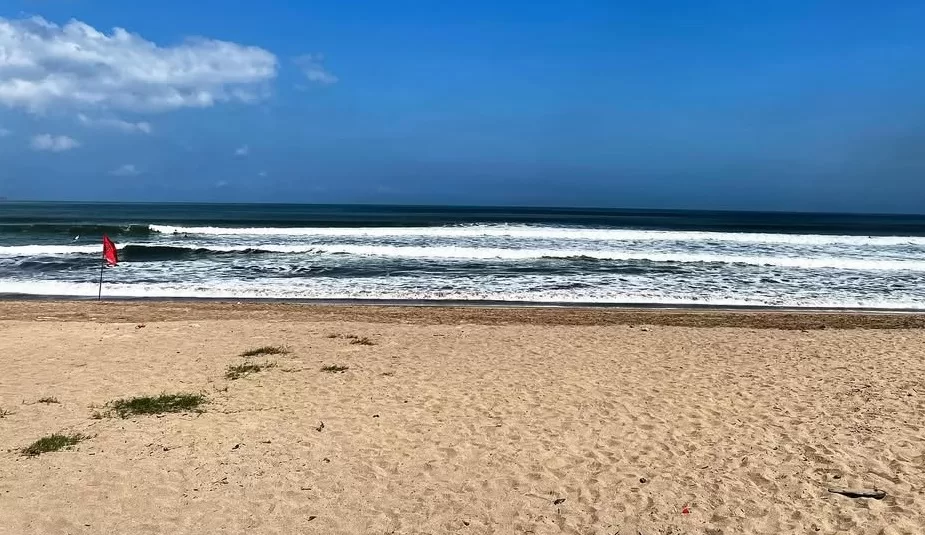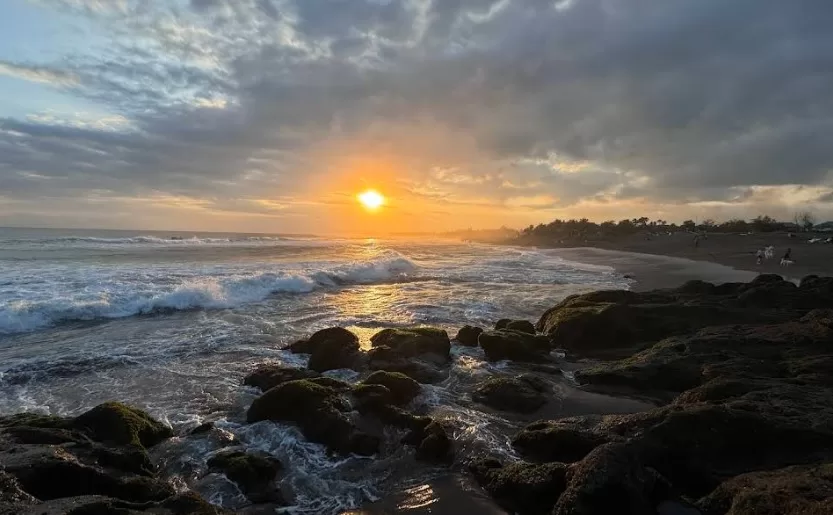Have you ever wondered what secrets lie hidden within Bali’s ancient temples? As we explore Ubud’s lush landscapes, we find the mystical Elephant Cave. It’s a treasured gem in Bali’s cultural heritage.
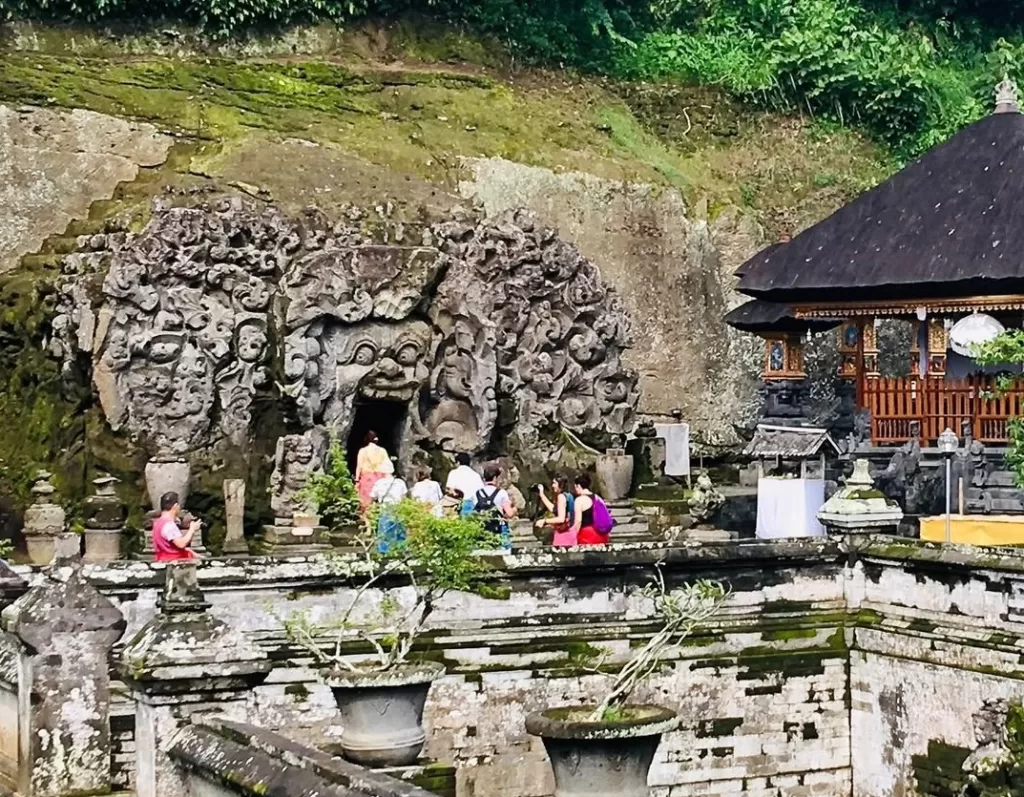
We’re excited to take you on a journey to explore the enchanting sanctuary. We’ll dive into its fascinating history and spiritual significance. This ancient temple is a must-see in Ubud, offering a peek into the island’s rich cultural past.
In our travel guide for Ubud, you’ll see why Goa Gajah is unique. It’s a sanctuary filled with mystery and intrigue.
Key Takeaways
- Discover the mystical allure of the Elephant Cave
- Explore the fascinating history and spiritual significance
- Uncover the secrets of Goa Gajah
- Learn about the cultural heritage of Bali
- Plan your visit with our travel guide for Ubud
The Mystical Allure of Goa Gajah: First Impressions
As we explore Ubud’s lush jungle, Goa Gajah calls to us. The air is filled with a magical energy. The entrance’s detailed carvings hint at a journey through time.
The Ancient Sanctuary Hidden in Ubud’s Jungle
Goa Gajah, or the Elephant Cave, is a hidden gem in Ubud’s jungle. It showcases the area’s rich culture with intricate carvings and statues. These reflect both Hindu and Buddhist traditions.
The calm atmosphere and beautiful nature make it a must-visit destination. It’s a place where you can feel Bali’s mystical charm.
Why This Sacred Site Captivates Visitors
Goa Gajah’s mix of history, spirituality, and beauty captivates everyone. It’s a key must-see attraction in Ubud. Here, you get a peek into Bali’s cultural past.
The site’s sacred energy is strong. It pulls visitors into a world of ancient rituals and mysticism. It’s a place that inspires wonder and awe.
The Fascinating History of Elephant Cave Ubud
The Elephant Cave in Ubud, Bali, has a rich history dating back to the 9th century. As we explore this ancient temple, we find layers of cultural and religious importance. These have shaped its identity over the years.
Origins Dating Back to the 9th Century
The Elephant Cave’s origins are mysterious, but records show it was built in the 9th century. This was a key time for Hindu-Buddhist culture in Bali. It was a spiritual retreat for monks and a place of worship for locals.
Some of the key features of the Elephant Cave from this time include:
- Intricate carvings of Hindu and Buddhist deities
- Ancient inscriptions on the walls, offering insights into its history
- The distinctive demonic face entrance, a hallmark of ancient Balinese temples
Archaeological Discoveries That Shaped Our Understanding
Excavations at the Elephant Cave have uncovered many artifacts, like statues, pottery, and ancient texts. These finds have greatly improved our understanding of the site’s history and culture. They show a mix of Hindu and Buddhist influences.
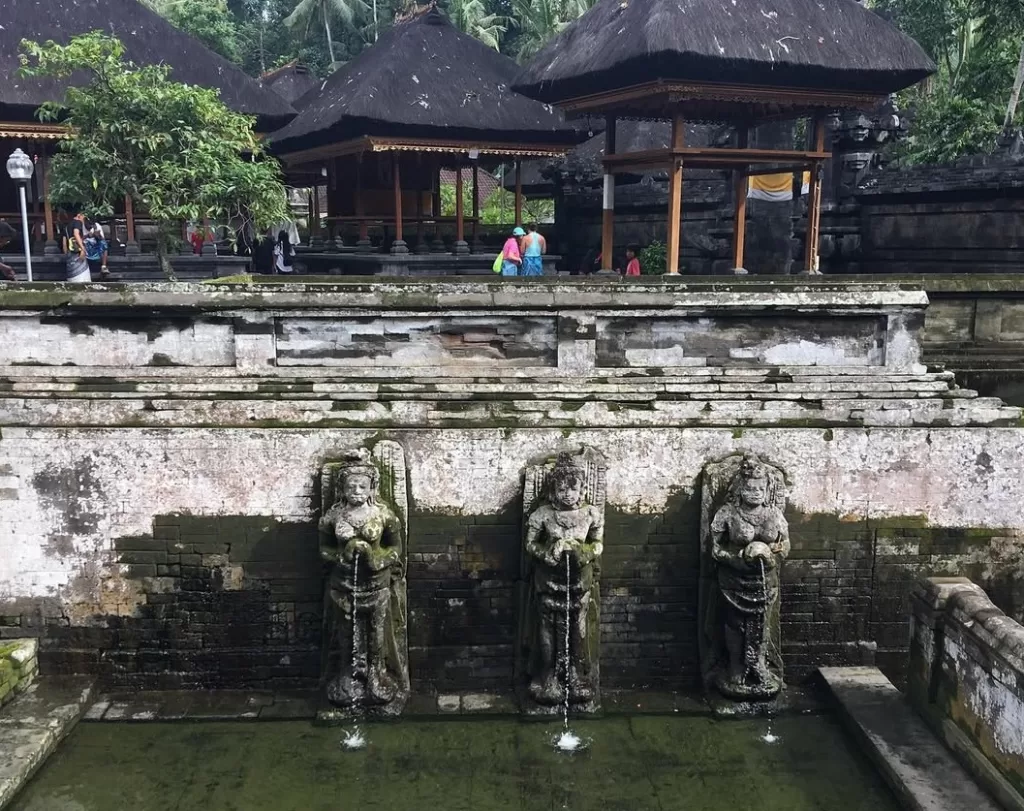
The discoveries have also shown the Elephant Cave’s importance as a hidden gem in Ubud. It offers a unique look into Bali’s rich cultural heritage. As we continue to learn about this site, we grow to appreciate its history and traditions.
5 Architectural Wonders of Goa Gajah
As we explore Ubud’s cultural heart, we find the Elephant Cave, or Goa Gajah. It shows the skill of Bali’s ancient people. This site is a marvel of architecture.
The Demonic Face Entrance
The entrance of Goa Gajah is a striking demonic face carved into the rock. It was made to keep evil spirits away. This iconic feature is a masterpiece and a sign of the site’s spiritual importance.
Ancient Meditation Caves
Exploring the Elephant Cave, we find ancient meditation caves. These were used by hermits and monks. They show the site’s role as a spiritual retreat.
Sacred Bathing Pools
The bathing pools at Goa Gajah are another wonder. They have intricate carvings and statues. These pools were for ritual purification and are still sacred today.
Hindu and Buddhist Relics
Goa Gajah houses a collection of Hindu and Buddhist relics. These show Bali’s cultural and spiritual diversity. The relics include statues, carvings, and other artifacts that highlight the region’s rich heritage.
The Surrounding Temple Complex
The temple complex around Goa Gajah is vast. It has shrines, altars, and other sacred structures. As a sacred site in Bali, it draws visitors from all over.
In conclusion, Goa Gajah’s 5 architectural wonders give us a peek into Ubud’s rich culture. It’s a key spot for anyone wanting to explore the Elephant Cave and its surroundings.
The Spiritual Significance: Where Two Religions Meet
Our journey into the Elephant Cave shows a blend of religious influences. This ancient site is a symbol of Hinduism and Buddhism living together. It creates a unique spiritual place that draws visitors from everywhere.
The Elephant Cave, also known as Goa Gajah, is a sacred site in Bali. It shows the island’s rich cultural heritage. As we explore, we see detailed carvings and statues that show the spiritual traditions of the area.
Hindu Elements and Symbolism
The Elephant Cave is full of Hindu symbols and elements. The entrance, with a demonic face, shows the victory of good over evil. Inside, we find meditation caves and sacred pools used for rituals.
- The walls have intricate carvings of Hindu deities and mythological scenes.
- The sacred pools were used for purification rituals.
- The temple complex has statues and reliefs from Hindu mythology.
Buddhist Influences and Artifacts
The Elephant Cave also shows Buddhist influences and artifacts. This highlights its importance in Buddhist tradition. The presence of Buddhist relics and statues shows the historical meeting of these two religions.
- Buddhist statues and artifacts reflect the Mahayana Buddhist tradition.
- The meditation caves were used by Buddhist monks.
- The mix of Hindu and Buddhist elements creates a unique spiritual atmosphere.
Exploring the Elephant Cave helps us understand its spiritual significance. It’s a must-see in Ubud, showing the religious harmony that defines Bali’s culture.
8 Essential Tips for Visiting Elephant Cave Ubud
Visiting the Elephant Cave Ubud is a mix of spirituality, history, and nature. These tips will help you get the most out of your visit. You’ll learn important information to make your trip better.
1. Best Times to Avoid Crowds
Visit the Elephant Cave early morning or late afternoon to avoid crowds. These times are quieter and better for photos. You’ll enjoy your visit more without the rush.
2. Entrance Fees and Hours
Know the entrance fees and hours before you go. The cave is open from 8 AM to 5 PM. The fee is about IDR 50,000 (USD 3.50). This info helps plan your day.
3. Appropriate Dress Code
Wear modest clothes to show respect. Cover your shoulders and knees. Also, wear comfy shoes for walking.
4. Guided Tour Recommendations
Take a guided tour for a better experience. Guides share the cave’s history and cultural importance. They help you see more and understand better.
5. Photography Guidelines
Photography is okay, but be respectful. Don’t use flash or tripods in sensitive areas. Always ask before taking photos of people or guides. This way, everyone enjoys the visit.
6. Cultural Etiquette to Observe
Respect local customs at the Elephant Cave. Remove shoes in temples, don’t point with your feet, and be quiet during ceremonies. This keeps the atmosphere positive.
7. What to Bring Along
Bring water, sun protection, and a snack. These items make your visit more comfortable. You’ll be ready to explore.
8. Accessibility Considerations
The cave is mostly easy to get around, but some spots might be hard for those with mobility issues. Knowing this helps plan your visit better.
Follow these eight tips to have a great time at the Elephant Cave Ubud. It’s a place of history, spirituality, and nature. You’ll surely remember your visit.
6 Hidden Gems Within the Elephant Cave Complex
As we explore the Elephant Cave complex, we find special treasures. There are many hidden spots that show the site’s deep cultural and spiritual value.
Lesser-Known Meditation Spots
There are quiet spots for meditation hidden in the complex. These places offer a calm setting, ideal for finding inner peace.
Ancient Inscriptions and Their Meanings
The complex has ancient inscriptions that are very important. They tell us about the site’s history and the people who lived here.
The Women’s Bathing Temple
The women’s bathing temple is a key part of the complex. It’s a place for ritual cleansing and spiritual growth. It shows the site’s rich cultural history.
Sacred Banyan Trees
The complex is surrounded by sacred banyan trees. These trees are important for their spiritual value. They offer shade and peace.
Ceremonial Spaces Still in Use Today
Many ceremonial spaces in the complex are still used today. They host rituals and ceremonies all year. Visitors can see the lively cultural practices here.
Panoramic Viewpoints
The complex has spots with amazing views of Ubud’s countryside. These viewpoints are great for taking in the beauty of the area.
Beyond the Cave: 4 Must-See Attractions Nearby
Exploring beyond the Elephant Cave in Ubud reveals a wealth of attractions. These spots highlight the area’s natural splendor and cultural richness. They cater to all interests, from nature fans to culture buffs.
Let’s dive into four attractions that will make your Ubud trip unforgettable:
Tegenungan Waterfall
Tegenungan Waterfall is a short drive from the Elephant Cave. It’s ideal for a cool swim or a peaceful picnic. The waterfall is set in lush greenery, offering a calm escape.
Ubud Monkey Forest
The Ubud Monkey Forest is a key attraction, housing over 700 Balinese macaques. It’s a natural and spiritual haven, with ancient temples and statues that showcase local traditions.
Local Artisan Villages
Ubud is famous for its artisan communities. Visiting these villages lets you see traditional crafts like woodcarving, painting, and weaving. You can even join workshops to learn these skills.
Traditional Balinese Rice Terraces
Seeing the Balinese rice terraces is a must in Ubud. These beautifully designed fields showcase local farming methods. They also offer breathtaking views, especially at sunset.
These spots, among others, make Ubud a captivating place for all. Whether you’re into nature, culture, or just want to unwind, there’s plenty to explore around the Elephant Cave.
The Complete Visitor’s Experience: What to Expect
Visiting the Elephant Cave Ubud is an adventure that combines history, spirituality, and natural beauty. We can expect a journey through time, from the moment we arrive to the moment we depart.
From Arrival to Departure: A Timeline
Upon arrival, we are greeted by the imposing demonic face entrance. This sets the tone for the spiritual and historical journey ahead. We then explore ancient meditation caves, sacred bathing pools, and the temple complex.
The visit usually lasts about an hour to an hour and a half. This depends on our interest and the pace we choose.
To make the most of our visit, we should plan to arrive early in the morning or later in the afternoon. This helps avoid the peak sun and crowds. Wearing modest clothing that covers our shoulders and knees is a sign of respect for the site’s religious significance.
Seasonal Variations and Special Events
The experience of visiting the Elephant Cave Ubud can vary with the seasons. During the dry season, the paths are clearer, and the weather is better for exploration. In contrast, the wet season brings a lush green landscape, making the surroundings breathtaking.
Additionally, special events and ceremonies can take place throughout the year. These offer a glimpse into the local culture and traditions.
By understanding the timeline and being aware of the seasonal variations and special events, we can tailor our visit. This ensures a memorable and enriching experience.
Why the Elephant Cave Remains One of Ubud’s Treasures
Our journey to the Elephant Cave Ubud shows why it’s a top treasure in Ubud. This ancient site, known as Goa Gajah, is a mix of history, spirituality, and architecture. It draws visitors from all over the world.
The Elephant Cave is special among Bali’s sacred sites. It has ancient meditation caves, sacred pools, and relics from Hindu and Buddhist traditions. It’s a place of wonder for those who love history and spirituality.
We hope this guide has sparked your interest in Ubud. Whether you’re drawn to its spiritual side or just want to see a famous spot, the Elephant Cave will impress you deeply.
FAQ
What is the Elephant Cave in Ubud, and why is it significant?
The Elephant Cave, also known as Goa Gajah, is an ancient sanctuary. It shows Bali’s rich cultural heritage and spiritual importance. It’s a top spot in Ubud, with detailed carvings, meditation caves, and sacred pools.
What are the opening hours and entrance fees for the Elephant Cave?
For the latest on opening hours and fees, check the official website or contact the local tourism office. They can give you the most current information.
How do I dress appropriately when visiting the Elephant Cave?
Dress modestly when visiting the Elephant Cave. Cover your shoulders and knees as a sign of respect. You might need to wear a sarong or sash around your waist.
Can I take guided tours of the Elephant Cave, and are they recommended?
Yes, guided tours are available and highly recommended. They help you understand the site’s history, cultural significance, and spiritual importance. Our guides can share valuable insights and answer your questions.
Are there any specific cultural etiquette or rules to observe when visiting the Elephant Cave?
Yes, be respectful of the site’s cultural and spiritual significance. Remove your shoes in temples or sacred areas. Don’t touch or handle artifacts. Be mindful of your surroundings.
What are some must-see attractions near the Elephant Cave in Ubud?
Near the Elephant Cave, don’t miss the Tegenungan Waterfall, Ubud Monkey Forest, local artisan villages, and traditional Balinese rice terraces. Exploring these places lets you see the region’s natural beauty and cultural richness.
Are there any hidden gems or lesser-known areas within the Elephant Cave complex?
Yes, the Elephant Cave complex has hidden gems. Look for lesser-known meditation spots, ancient inscriptions, the women’s bathing temple, sacred banyan trees, and ceremonial spaces still in use today. Exploring these areas can reveal the site’s secrets.
Can I visit the Elephant Cave during special events or festivals?
Yes, the Elephant Cave hosts cultural and spiritual events throughout the year. Check the local event calendar to visit during these special occasions. However, be prepared for larger crowds

